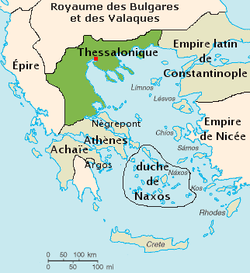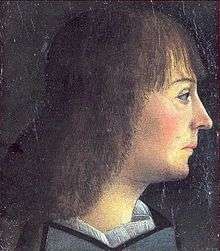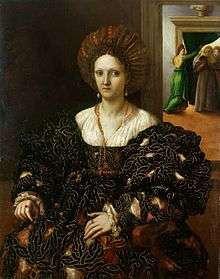Palaeologus-Montferrat
The House of Palaeologus-Montferrat or Palaiologos-Montferrat, or just Palaeologus or Paleologo, was an Italian noble family and a cadet branch of the Palaiologos dynasty, the last ruling family of the Byzantine Empire. The cadet branch was created in 1306 when Theodore Palaiologos, fourth son of Byzantine Emperor Andronikos II Palaiologos, inherited the March of Montferrat through his mother, and Andronikos II's second wife, Yolande of Montferrat.
| Palaeologus-Montferrat Palaiologos, Paleologo | |
|---|---|
 Late 15th century coat of arms, as used by William IX Palaeologus | |
| Parent house | Palaiologos (agnatic) Aleramici (cognatic) |
| Country | March of Montferrat |
| Founded | 1306 |
| Founder | Theodore Palaiologos |
| Final ruler | John George Palaeologus |
| Final head | Margaret Paleologa |
| Titles | Marquis of Montferrat |
| Traditions | Roman Catholicism |
| Dissolution | 1566 |
| Deposition | 1533 |
The Aleramici, Yolande's house and the previous rulers of Montferrat, had ruled the Kingdom of Thessalonica, a crusader state established around the city of Thessalonica after the Fourth Crusade in 1204. Though the resurgent Byzantines had reconquered Thessalonica in 1224, the Aleramici family still retained claims to the title. Because Andronikos II was eager to establish himself as legitimate in the eyes of Western Europe, he married Yolande in an effort to formally unite the claims of her family with his own de facto rule of Thessalonica, avoiding the potential future threat of a pretender launching an invasion against the empire.
At the time of their marriage, Yolande was second-in-line to the throne of Montferrat, and when her brother, John I of Montferrat, died without children in 1305, rulership of Montferrat legitimately passed to Yolande and her children, Theodore being chosen to make the journey to Italy and establish himself there. Many of the more conservative parts of the Byzantine aristocracy feared that Theodore and his descendants would become 'latinized'; fears that were realized once Theodore adopted Western customs and converted to Roman Catholicism.
Although the Montferrat Palaiologoi continued to use typical Greek names, such as Theodore or Sophia, from time to time, and a handful of marquises had Byzantine aspirations, they tended to pay relatively little attention to events and affairs in the eastern Mediterranean. The imperial branch of the Palaiologos family were displaced in 1453 through the Fall of Constantinople, but the Montferrat cadet branch continued to rule Montferrat for almost another century after that, being replaced by the House of Gonzaga in 1533 after the death of the last male member of the house, John George Palaeologus. The last female member, Margaret Paleologa, died in 1566, rendering the house extinct. Their descendants are still alive today, both in the form of branches descended from illegitimate children and through matrilineal descent in several Italian noble houses, such as the House of Savoy.
History
Background

The ruling house of Montferrat, the Aleramici family, had been interconnected with the Byzantine Empire and its rulers for some time before the Palaiologoi gained Montferrat. In 1179, Emperor Manuel I Komnenos (r. 1143–1180) married his daughter Maria Komnene to Renier of Montferrat, who was granted the city of Thessalonica to rule as a pronoia. Because of this family connection, Renier's brother Boniface, a leading figure in the Fourth Crusade, could claim and conquer the "Kingdom of Thessalonica" in 1204. Though the Byzantines of Epirus retook Thessalonica in 1224, the Aleramici still retained their claims to the city and the kingdom they had created around it.[1]
In 1284, Yolande of Montferrat, the daughter of the ruling Marquis of Montferrat, William VII, married Emperor Andronikos II Palaiologos of the Byzantine Empire (r. 1282–1328) and was given the titles associated with Thessalonica by her father as her dowry, though it is unclear if she was meant to possess them or if she was intended to transfer them to her husband, who actually ruled Thessalonica as part of his empire. Yolande retained her place in the Monferratian line of succession, second-in-line after her brother John, should he die without children. Upon her marriage to Andronikos, Yolande was given the Greek name Irene. The reason for Andronikos opting to marry Irene probably had to do with the emperor wishing to establish his legitimacy in regards to Western Europe. Although the Palaiologoi ruled the Byzantine Empire, which had controlled Greece and Anatolia since ancient times, many in Western Europe viewed them as usurpers, since they had supplanted the Catholic Latin Empire, established in 1204 after the Fourth Crusade. Through marriage alliances with western pretenders to the Latin Empire, or parts of it, Andronikos would have been able to achieve full recognition of his rule in the West. In addition to his own marriage to the pretender to Thessalonica, Andronikos also unsuccessfully attempted to marry his son, Michael IX Palaiologos, to Catherine of Courtenay, the recognized heir to the Latin Empire itself.[2]
In his marriage negotiations with William VII, Andronikos paid William 6,000 livres génois, amounting to the revenue Andronikos and his father, Emperor Michael VIII Palaiologos (r. 1259–1282), had received from "the Kingdom of Thessalonica which belonged to the Marquis". Furthermore, Andronikos pledged 500 soldiers, stationed in Lombardy throughout William's lifetime, to aid the Marquis in his wars against the Angevins. The marriage between Andronikos and Irene had the unexpected result of giving the Byzantine imperial family the possibility of inheriting the throne of Montferrat.[3]
Foundation
In January 1305, John I of Montferrat, Irene's brother, died without children. John's will specified that in the absence of heirs of his own, Montferrat should go to Irene and her sons. In March, envoys left Montferrat to ask Irene, or one of her sons, to travel to Italy and claim their inheritance.[3] After receiving the news, Irene and Andronikos clashed over which of their sons was to inherit Montferrat. The Emperor wanted to send their youngest son, Demetrios, but Irene preferred Theodore, who was older and from Thessalonica, and sent him instead.[4] Irene had initially preferred the couple's oldest son John, also preferred by the envoys on account of primogeniture and his older age, but this suggestion was blocked by both the Emperor and the Patriarch of Constantinople, Athanasius I, since sending John, third-in-line to the Byzantine throne, to the West was seen as jeopardizing their own line of succession.[5] Though the Byzantines in ages past would have welcomed the opportunity to send a member of the imperial family to establish a foothold in Italy, the Byzantines of the 14th century recognized that it was the Italians that would profit from a connection with the imperial family, and not the other way around. The possibility that the Italians would launch an attack on the empire as a result of the Monferrat inheritance was entertained by the Patriarch, who opposed the entire affair.[6]
Theodore did not arrive in Italy until the late summer of 1306,[7] aged 15.[8] Theodore himself ascribed the delay to Andronikos not finding enough ships nor enough time to make the necessary preparations for the journey. Another likely reason was that the Marquis of Saluzzo, Manfred IV, had attacked Monferrat, claiming that John I's widow, Margarita, was pregnant and that since an heir would thus be produced, a Byzantine prince was unnecessary. Theodore was not sent to Monferrat until Manfred's claim were uncovered to be a lie. Before leaving Byzantium, Theodore also married Argentina Spinola, the daughter of Opicino Spinola, a merchant and one of the "Captains of the People" of Genoa.[7] Theodore's fate was a shock to some of the more conservative members of the Byzantine aristocracy; not only had a young Byzantine prince, born in the purple, been sent to live among, and rule over, Latin barbarians, but he had also chosen to marry not only a commoner, but a Latin commoner.[9] Theodore's marriage to Argentina might have been payment to Genoa for Genoese assistance against the Catalans in Andronikos II's wars.[10]
Byzantine fears that Theodore would become "Latinized" were quickly realized. Theodore converted to Roman Catholicism and on his occasional journeys to Constantinople startled the Byzantines with his Western customs and his shaven face. In the 1320s, Theodore was one of the most directly involved and influential figures in Andronikos II's negotiations and hopes for a union between the Orthodox and Catholic churches. One of Theodore's preserved literary works, a treatise on war and government, expresses western feudal practices and ideas and is notably missing contemporary Byzantine ideas.[11] Throughout his reign, Theodore was mainly preoccupied with maintaining his position within the March of Montferrat.[8]
'Latinization' and attitude towards Byzantium

Theodore founded the Palaeologus-Montferrat cadet branch of the Palaiologos dynasty,[12] fusing and subsuming the Aleramici lineage with a succession that derived from Byzantium and carried the name of the Palaiologan emperors.[8] which would rule Monferrat until the 16th century. Although the Palaiologoi of Montferrat were Latinized, there still had some ties to their homeland; notably reflected in several of them being given typically Greek names, such as Theodore and Sophia. Additionally, they held strong ties to Genoa. Though the Byzantines had seen Argentina Spinola as a mere commoner, her family held significant political power in Genoa. Theodore II of Montferrat, Theodore I's grandson, even managed to take control of the city in 1409, ruling there until 1413.[12]
Theodore I's successor as Marquis of Montferrat, his son John II Palaeologus, attempted to take advantage of the Byzantine civil war of 1341–1347, between Andronikos II's great-grandson John V Palaiologos and John VI Kantakouzenos, in order to invade the empire and conquer Thessalonica. In his 1372 will, John II claimed that Andronikos II's deposition in 1328 by his grandson Andronikos III Palaiologos (John V's father) had been unlawful and thus disqualified Andronikos III and all his heirs from the legitimate line of succession to the throne of Byzantium. John II also pointed out that since Andronikos II had disinherited Andronikos III, John II was thus the rightful emperor as the only true heir to Andronikos II.[11] John II even petitioned the Papacy to recognize his claims to Thessalonica and to the empire, and to help him conquer them.[13] An expedition to "recover" these territories was never organized.[8] Although John II's claims were theoretically inherited by his descendants, none of the marquises seriously pursued a policy of taking over the Byzantine Empire, most of them paying little attention to affairs in the East.[14]
In 1420, Sophia of Montferrat, the great-granddaughter of Theodore I, was chosen by Emperor Manuel II Palaiologos and Pope Martin V to marry her distant relative, John VIII Palaiologos, then the heir to the Byzantine throne.[15] Manuel II agreed to this marriage not because they were related, but because Sophia held connections to Montferrat and Genoa, valuable allies, and because she had been suggested by the Pope. Pope Martin V himself might have been interested in securing the allegiance of Montferrat by suggesting an imperial marriage.[16] Their marriage was not a happy one, on account of John VIII finding Sophia unattractive,[17] and Sophia left John VIII in 1426, returning to Italy. John remarried in the following year.[18]
Extinction and descendants

The Palaeologus-Montferrat family repeatedly intermarried with the powerful House of Savoy. In 1330, Theodore I's daughter, Yolande Palaeologina of Montferrat, married Aymon, Count of Savoy, and in 1411, a daughter of Amadeus VII, Count of Savoy, Joanna, married John Jacob, Marquis of Montferrat. The marriage contract between Yolande and Aymon in 1330 specified that in the event of the extinction of the Palaeologus-Montferrat line, the House of Savoy was to inherit Montferrat. This contract must only have been a distant memory when the final Palaeologus Marquis, John George, Marquis of Montferrat, died in 1533. Though the then current Savoyard heir, Charles III, Duke of Savoy, made a claim to the title, the Montferrat territories were instead given to a rival contender, Federico II Gonzaga, Duke of Mantua, by Holy Roman Emperor Charles V.[19] In 1708, the House of Savoy, through Victor Amadeus II of Sardinia, succeeded in claiming Montferrat, the acquisition of which was confirmed in 1713 through the Peace of Utrecht, which ended the War of the Spanish Succession. The House of Savoy, which ruled all of Italy 1861–1946, represents still-living descendants of the Palaeologus-Montferrat family.[20]
Federico II Gonzaga, who had succeeded the Palaeologus-Montferrat family in 1533, was connected to the family by marriage, being the husband of Margaret Paleologa, niece of John George. Federico had married Margaret on 3 October 1531 with the explicit goal of acquiring Montferrat.[21] With Margaret's death in 1566, the Palaeologus-Montferrat family became extinct. Her and Federico II's descendants, with the Gonzaga name, ruled Montferrat until they were supplanted by the House of Savoy.[20]
A surviving lineage, called the Paleologo-Oriundi, are descended from Flaminio, an illegitimate son of John George.[22][23] The name "Montferrato-Paleologo" is recorded on the Greek island of Cephalonia until the 17th century.[24]
Family tree
In order to conserve space, the family tree only displays people of male-line descent who survived until adulthood. Marquises are indicated with bold text and women are indicated with italics.
| Theodore I | |||||||||||||||||||||||||||||||||||||||||||||||||||||||||||||
| Yolande | John II | ||||||||||||||||||||||||||||||||||||||||||||||||||||||||||||
| Secondotto | John III | Theodore II | William | Margaret | |||||||||||||||||||||||||||||||||||||||||||||||||||||||||
| John Jacob | Sophia | ||||||||||||||||||||||||||||||||||||||||||||||||||||||||||||
| John IV | Amadea | Isabella | William VIII | Boniface III | Theodoro | ||||||||||||||||||||||||||||||||||||||||||||||||||||||||
| Elena Margherita | Sara | Scipione | Giovanna | Blanche | William IX | John George | Francesca | ||||||||||||||||||||||||||||||||||||||||||||||||||||||
| Maria | Margaret | Boniface IV | Flaminio | ||||||||||||||||||||||||||||||||||||||||||||||||||||||||||
References
- Laiou 1968, p. 387.
- Laiou 1968, pp. 387–388.
- Laiou 1968, p. 390.
- Laiou 1968, p. 391.
- Laiou 1968, p. 392.
- Laiou 1968, p. 393.
- Laiou 1968, p. 395.
- Barker 2017, p. 167.
- Laiou 1968, p. 386.
- Laiou 1968, p. 400.
- Laiou 1968, p. 402.
- Dąbrowska 1996, p. 180.
- Laiou 1968, p. 403.
- Barker 2017, p. 168.
- Dąbrowska 1996, p. 181.
- Dąbrowska 1996, p. 182.
- Barker 2017, p. 172.
- Dąbrowska 1996, pp. 189–190.
- Barker 2017, p. 175.
- Barker 2017, p. 176.
- Fenlon 1980, p. 48.
- Cassano 2017, pp. 3–9.
- http://giorgioqp.blogspot.com/2015/05/roots-paternal-grandmother-ida-quintini.html
- Nicol 1992, p. 118.
Cited bibliography
- Barker, John W. (2017). "Crusading and Matrimony in the Dynastic Policies of Montferrat and Savoy" (PDF). Byzantion Nea Hellás. 36: 157–183.
- Cassano, Gian Paolo (July 2017). "Organo di informazione del Circolo Culturale "I Marchesi del Monferrato" "in attesa di registrazione in Tribunale"" (PDF). Bollettino del Marchesato. Cassa di Risparmio di Alessandria. 3 (16): 3–9.
- Dąbrowska, Malgorzata (1996). "Sophia of Montferrat, or The History of One Face" (PDF). Acta Universitatis Lodziensis. 56: 177–194.
- Fenlon, Iain (1980). Music and Patronage in Sixteenth-Century Mantua. Volume 1. Cambridge University Press. OCLC 5832030.
- Laiou, A. E. (1968). "A Byzantine Prince Latinized: Theodore Palaeologus, Marquis of Montferrat". Byzantion. 38 (2): 386–410.
- Nicol, Donald M. (1992). The Immortal Emperor: The life and legend of Constantine Palaiologos, last Emperor of the Romans. Cambridge University Press. ISBN 0-521-41456-3.